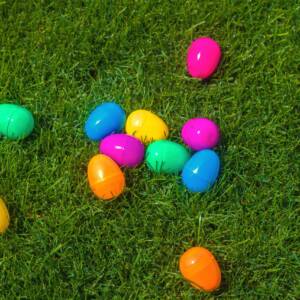
Easter is around the corner and that gets us thinking about putting together alternatives to the traditional Easter basket and celebration, to help you in creating sensory-friendly Easter. If you are putting together a basket for someone that has a challenged sensory system you will want to remember to keep it fun and fill it with items you are sure they will enjoy as a sensory seeker or sensory avoider. Basket grass is certainly something that those considered to be avoiders may want to stay away from. When we plan for our eggciting day, we always start with a K.I.S.S. (keep it simple silly), as we have found too many choices in a basket and too many events can be overwhelming.
When selecting items for the sensory themed Easter basket, think about the body’s sensory system and choose small items that could stimulate any of the 7 senses. Chewigem’s are nicely sized to fit in most baskets and fall under the oral motor sensory diet. They are a safe alternative for chewing, sucking, and biting and assist with self-regulation. Touch & feel books and nubbed sensory balls are a great addition for enhancing tactile development. Egg-shaped shakers are a great idea for auditory stimulation and also go with the theme of the basket. We have also put quarters and Lego mini-figures inside of the plastic eggs to add to this element. Adult supervision is required when playing with small items.
Traditional Easter egg hunts can be challenging for those that get overstimulated by crowds, loud noises and change in routine. We have had some of our best hunts in our home where the surroundings are familiar, the temperature is constant and the couch is close when we need to rest. Of course, going outdoors gives the opportunity to use other sensory friendly items such as shaving cream, play dough, bubbles, sidewalk chalk and water beads.
There are so many outdoor sensory activities that can be done instead of having a traditional egg hunt. A few minutes of vestibular activities throughout the day can help with focus and daily tasks. Get other members of the family involved and create an obstacle course using rope swings, tunnels, water tables, trampolines, etc. The idea is to get moving and be together. Fill plastic eggs with water or water beads and have an egg toss. Make bunny ears and have a bunny hop race. Grab a hardboiled egg and stick and time each other guiding the egg through an obstacle course. Rest on a crash pad or swing in a hammock and share your favourite Easter memories.
Loads of fun awaits the sensory seekers and avoiders during the Easter season. There are many therapeutic alternatives to use as small fillers for Easter baskets. The best way to enjoy the day is to have few expectations of what is right or wrong. Follow the lead of the individual with sensory insecurities and have fun.
Unsure if there is a sensory issue at play? These signs may indicate that a sensory sensitivity exists and further evaluation may be needed.
We hope that these tips have been helpful for you when thinking about creating a sensory-friendly Easter for your child.
If you ever need any support why not join our FREE Facebook group – The Chewigem Sensory Support Group!
We hope to see you there!
Sensory Matters Podcast
Free Sensory Support Community
Can Chewigems Help Keep Your Teeth Clean?